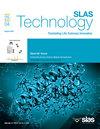Automation of protein crystallization scaleup via Opentrons-2 liquid handling
IF 3.7
4区 医学
Q3 BIOCHEMICAL RESEARCH METHODS
引用次数: 0
Abstract
In this study we present an approach for optimizing protein crystallization trials at the multi-microliter scale utilizing the Opentrons-2 liquid handling robot. Our research demonstrates the robot's capability to automate 24-well sitting drop protein crystallization trials. Using Python scripts for precise control, the study explores the robot's application in mixing and setting up crystallization plates with a model protein (hen egg white lysozyme) and a periplasmic protein from Campylobacter jejuni, a crystal utilized in the Snow lab as a biomaterial for nanotechnology that requires large, consistent batches. In a head-to-head comparison with manual 24-well plate setup, crystal growth statistics indicate our approach can reduce manual labor and increase reliability in protein crystallization, and may also reduce variability, offering an economical and versatile tool for laboratories. This study shows facile adaption of the Opentrons interface and hardware for growth of two different crystal types. All developed liquid handling routines and relevant data files, in addition to demonstration videos are available at https://github.com/jbderoo/Opentrons2-Protein-Crystallization

利用Opentrons-2液体处理实现蛋白质结晶放大的自动化。
在这项研究中,我们提出了一种利用Opentrons-2液体处理机器人在多微升尺度上优化蛋白质结晶试验的方法。我们的研究证明了机器人能够自动进行24孔坐滴蛋白结晶试验。使用Python脚本进行精确控制,该研究探索了机器人在混合和设置结晶板中的应用,结晶板中含有模型蛋白(蛋清溶菌酶)和空肠弯曲杆菌的质周蛋白,这是Snow实验室使用的一种晶体,作为纳米技术的生物材料,需要大量一致的批量。在与人工24孔板设置的直接比较中,晶体生长统计数据表明,我们的方法可以减少人工劳动,提高蛋白质结晶的可靠性,还可以减少可变性,为实验室提供经济和通用的工具。该研究表明,Opentrons接口和硬件可以很容易地适应两种不同晶体类型的生长。所有开发的液体处理程序和相关数据文件以及演示视频均可在https://github.com/jbderoo/Opentrons2-Protein-Crystallization上获得。
本文章由计算机程序翻译,如有差异,请以英文原文为准。
求助全文
约1分钟内获得全文
求助全文
来源期刊

SLAS Technology
Computer Science-Computer Science Applications
CiteScore
6.30
自引率
7.40%
发文量
47
审稿时长
106 days
期刊介绍:
SLAS Technology emphasizes scientific and technical advances that enable and improve life sciences research and development; drug-delivery; diagnostics; biomedical and molecular imaging; and personalized and precision medicine. This includes high-throughput and other laboratory automation technologies; micro/nanotechnologies; analytical, separation and quantitative techniques; synthetic chemistry and biology; informatics (data analysis, statistics, bio, genomic and chemoinformatics); and more.
 求助内容:
求助内容: 应助结果提醒方式:
应助结果提醒方式:


